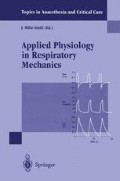Abstract
Mechanical ventilation is a technique which, although frequently life-saving, carries nevertheless the potential risk of severe complications [1]. Of these adverse effects, some are the direct consequence of pulmonary pressure and/or volume changes induced by mechanical insufflation of diseased lungs. Barotrauma is the usual term for such complications and refers to the presence of extra-alveolar air (manifesting as interstitial emphysema, pneumomediastinum or pneumoperitoneum, pneumothorax, etc.). In addition to these “macroscopic” alterations, it has been experimentally demonstrated that lung distension during mechanical ventilation may induce alterations of lung fluid balance, increases in endothelial and epithelial permeability and severe ultrastructural damage. These abnormalities may culminate in the production of a pulmonary permeability-type edema accompanied by diffuse alveolar damage.
Access this chapter
Tax calculation will be finalised at checkout
Purchases are for personal use only
Preview
Unable to display preview. Download preview PDF.
References
Pingleton SK (1988) Complications of acute respiratory failure. Am Rev Respir Dis 137: 1463–1493
Webb HH, Tierney DF (1974) Experimental pulmonary edema due to intermittent positive pressure ventilation. Protection by positive end-expiratory pressure. Am Rev Respir Dis 110: 556–565
Kolobow T, Moretti MP, Fumagalli R, Mascheroni D, Prato P, Chen V, Joris M (1987) Severe impairment in lung function induced by high peak airway pressure during mechanical ventilation. An experimental study. Am Rev Respir Dis 135: 312–315
Tsuno K, Prato P, Kolobow T (1990) Acute lung injury from mechanical ventilation at moderately high airway pressures. J Appl Physiol 69: 956–961
Parker JC, Townsley MI, Rippe B, Taylor AE, Thigpen 1 (1984) Increased microvascular permeability in dog lungs due to high peak airway pressures. J Appl Physiol 57: 1809 1816
Egan EA, Nelson RM, Olver RE (1976) Lung inflation and alveolar permeability to non-electrolytes in the adult sheep in vivo. J Physiol 260: 409–424
Dreyfussl D, Basset G, Soler P, Saumon G (1985) Intermittent positive-pressure hyperventilation with high inflation pressures produces pulmonary microvascular injury in rats. Am Rev Respir Dis 132: 880–884
Parker JC, Hernandez LA, Longenecker GL, Peevy K, Johnson W (1990) Lung edema caused by high peak inspiratory pressures in dogs. Role of increased microvascular filtration pressure and permeability. Am Rev Respir Dis 142: 321–328
Carlton D, Cummings JJ, Scheerer RG, Poulain FR, Bland RD (1990) Lung overexpansion increases pulmonary microvascular protein permeability in young lambs. J Appl Physiol 69: 577–583
Dreyfussl D, Soler P, Basset G, Saumon G (1988) High inflation pressure pulmonary edema. Respective effects of high airway pressure, high tidal volume and positive end-expiratory pressure. Am Rev Respir Dis 137: 1159–1164
Hernandez LA, Peevy KJ, Moise AA, Parker JC (1989) Chest wall restriction limits high airway pressure-induced lung injury in young rabbits. J Appl Physiol 66: 2364–2368
Dreyfussl D, Saumon G (1993) Role of tidal volume, FRC and end-inspiratory volume in the development of pulmonary edema following mechanical ventilation. Am Rev Respir Dis 148: 1194–1203
Bowton DL, Kong D L (1989) High tidal volume ventilation produces increased lung water in oleic acid-injured rabbit lungs. Crit Care Med 17: 908–911
Hernandez LA, Coker PJ, May S, Thompson AL, Parker JC (1990) Mechanical ventilation increases microvascular permeability in oleic-acid injured lungs. J. Appl Physiol 69: 2057–2061
Dreyfussl D, Soler P, Saumon G (1991) High volume ventilation produces more severe damage in previously injured lungs. Am Rev Respir Dis 143 [Suppl.]: A251 (Abstract)
Forrest JB (1972) The effect of hyperventilation on pulmonary surface activity. Brit J Anaesth 44: 313–319
Wyszogrodski I, Kyei Aboagye K, Taeusch HW Jr, Avery ME (1975) Surfactant inactivation by hyperventilation: conservation by end-expiratory pressure. J Appl Physiol 38: 461–466
Permutt S (1979) Mechanical influences on water accumulation in the lungs. In: Fishman AP, Renkin EM (eds) Pulmonary edema. Clinical Physiology Series. American Physiological Society, Bethesda, pp 175–193
West JB, Tsukimoto K, Mathieu-Costello O, Prediletto R (1991) Stress failure in pulmonary capillaries. J Appl Physiol 70: 1731–1742
Dreyfussl D, Soler P, Saumon G (1992) Spontaneous resolution of the pulmonary edema caused by short periods of cyclic overinflation. J Appl Physiol 72: 2081–2089
Maunder RJ, Shuman WP, Mc Hugh JW, Marglin SI, Butler J (1986) Preservation of normal lung regions in the adult respiratory distress syndrome. Analysis by computed tomography. JAMA 255: 2463–2465
Editor information
Editors and Affiliations
Rights and permissions
Copyright information
© 1998 Springer-Verlag Italia
About this chapter
Cite this chapter
Dreyfussl, D., Saumon, G. (1998). Volutrauma and barotrauma. In: Milic-Emili, J. (eds) Applied Physiology in Respiratory Mechanics. Topics in Anaesthesia and Critical Care. Springer, Milano. https://doi.org/10.1007/978-88-470-2928-6_12
Download citation
DOI: https://doi.org/10.1007/978-88-470-2928-6_12
Publisher Name: Springer, Milano
Print ISBN: 978-88-470-2930-9
Online ISBN: 978-88-470-2928-6
eBook Packages: Springer Book Archive

